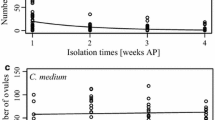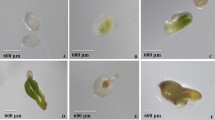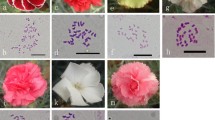Abstract
The applicability of ovule culture was examined in reciprocal crosses between the diploid species D. grandiflorum L. and the tetraploid cultivar D. hybridum ‘Galahad’. An interspecific hybrid plant of D. hybridum ‘Galahad’ × D. grandiflorum was obtained,and hybridity was confirmed by chromosome counting. The hybrid was different from the parents in flower color and size but intermediate between the parents in leaf shape. The hybrid showed low pollen fertility and failed to produce viable seeds by either self- or backcross-pollination using fertile pollen grains from its parents. The applicability and efficiency of the ovule culture technique for genetic improvement of the genus Delphinium through interspecific hybridization between different ploidies is discussed.
Similar content being viewed by others
References
Alexander, P., 1969. Differential staining of aborted and nonaborted pollen. Stain Technol 44: 117-122.
Allard, R.W., 1960. Principles of Plant Breeding, pp. 46-60. John Wiley & Sons, Inc.
Brigges, F.N. & P.F. Knowles, 1967. Introduction of Plant Breeding, pp. 99-117. Reinhold Publ. Corp.
Cooper, D.C. & R.A. Brink, 1940. Somatoplastic sterility as a cause of seed failure after interspecific hybridization. Genetics 25: 593-617.
Honda, K. & K. Tsutsui, 1997. Production of interspecific hybrids in the genus Delphinium via ovule culture. Euphytica 96: 331-337.
Ishizaka, H. & J. Uematsu, 1994. Amphidiploids between Cyclamen persicum Mill. and C. hederifolium Aiton induced through colchicine treatment of ovules in vitro and plants. Breed Sci 44: 161-166.
Legro, R.A.H., 1961a. Species hybrids in Delphinium. Euphytica 10: 1-23.
Legro, R.A.H., 1961b. Recent progress in breeding red and yellow Delphiniums. The Delphinium Society Year Book: 91-98.
Murashige, T. & F. Skoog, 1962. A revised medium for rapid growth and bioassays with tobacco tissue cultures. Physiol Plant 15: 473-497.
Royal Horticultural Society, 1949. A tentative check-list of Delphinium names. London.
Stebbins, G.L., 1950. Variation and Evolution in Plants. Columbia University Press, New York.
Takamura, T. & I. Miyajima, 1999. Varietal and individual differences in Cross-compatibility in the 2x × 4x crosses of Cyclamen Cyclamen persicum Mill.). J Japan Soc Hort Sci 68(1): 55-60.
Wilde, E.I., 1931. Studies of the genus Delphinium. Bull Cornell Univ Agric Exp, St, Ithaca, NY 519: 1-106.
Yabuya, T., 1985. Amphiploids between Iris laevigata Fisch. and I. ensata Thunb. induced through in vitro culture of embryos treated with colchicine. Japan J Breed 35: 136-144.
Author information
Authors and Affiliations
Rights and permissions
About this article
Cite this article
Honda, K., Watanabe, H. & Tsutsui, K. Use of ovule culture to cross between Delphinium species of different ploidy. Euphytica 129, 275–279 (2003). https://doi.org/10.1023/A:1022206731894
Issue Date:
DOI: https://doi.org/10.1023/A:1022206731894




